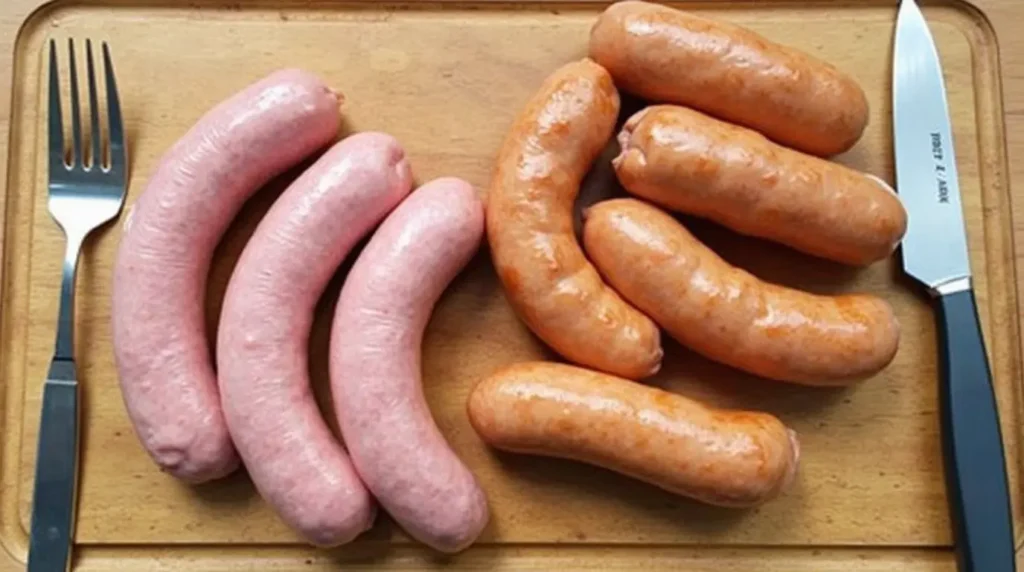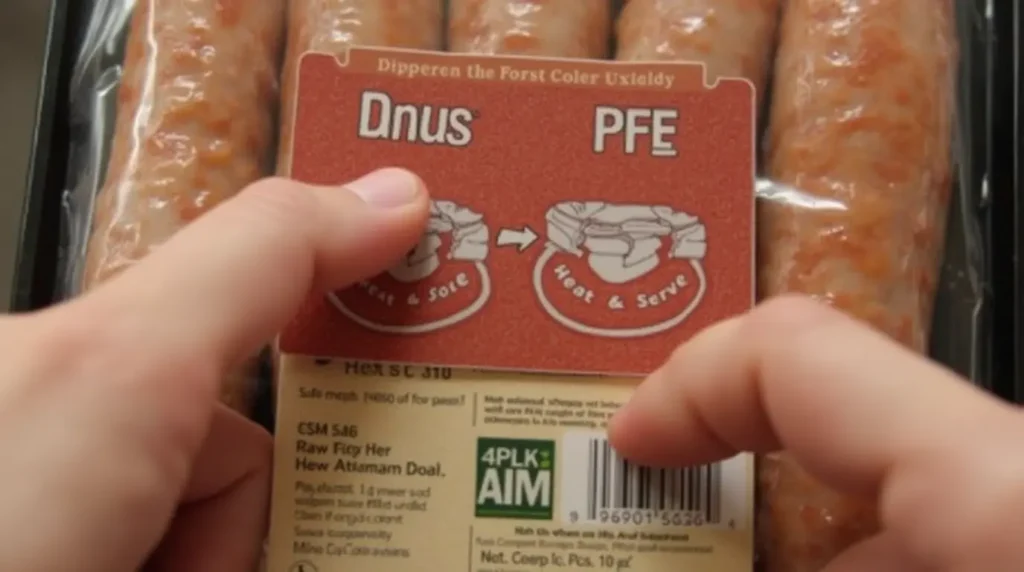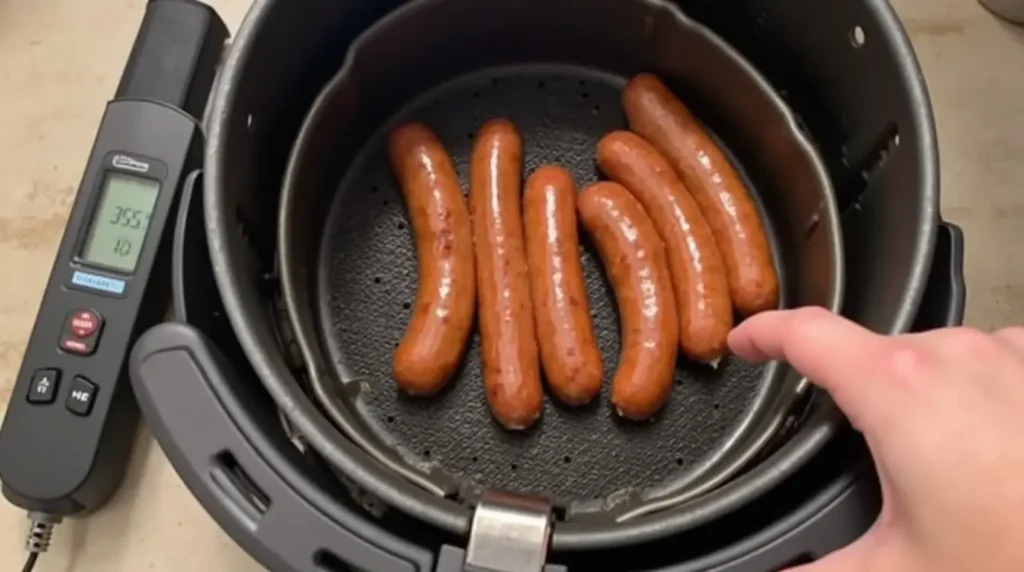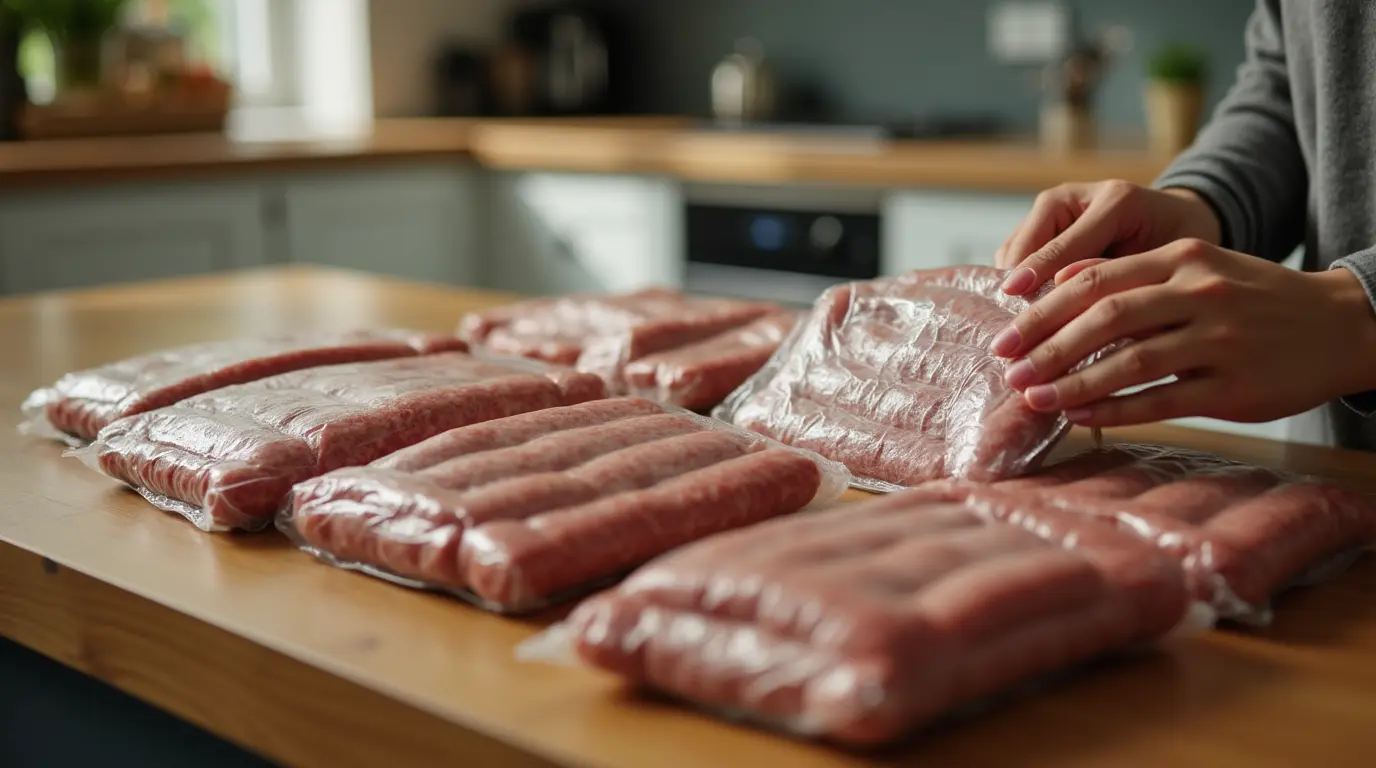Packaged sausages are convenient, flavorful, and adaptable to almost any meal. A common question many ask is, “Are packaged sausages already cooked?” The answer depends on the type, as some varieties are raw while others are fully cooked and ready to heat. You can find them in many stores, already sealed and labeled for freshness. Because of these differences, many shoppers feel confused about which type to buy or how to store them. This complete guide explains the basics, highlights the benefits of each option, and shows you the best ways to prepare them—especially in an air fryer. For more tips, check out how long sausages take in an air fryer.
Understanding Packaged Sausages
Overview of Packaged Sausages
Packaged sausages come in all sizes and flavors. Manufacturers blend ground meat (often pork, beef, or chicken) with salt, spices, and other ingredients to create distinct tastes. Once the mixture is formed, the sausages are placed in specific packaging. This can include vacuum-sealed bags or simple plastic wraps. Labels on these packages note whether the sausages are fresh (raw) or pre-cooked.
Most shoppers choose packaged sausages because of their versatility and easy availability. You can grill them, bake them, pan-fry them, or use them in the best way to cook sausages in air fryer. Varieties like Italian sausage, bratwurst, kielbasa, and hot dogs each have unique spice blends. Some include cheese, peppers, or herbs, while others remain plain and simple.
Common Types Available in Stores
- Fresh Sausages
Fresh sausages contain raw meat and must be cooked thoroughly. They usually provide juicier textures and stronger meat flavors if prepared correctly. - Pre-Cooked Sausages
Pre-cooked sausages are heated or smoked before packaging. This means they are safe to eat without further cooking, although most people prefer to warm them for better taste. - Seasoned or Flavored Varieties
You will find sausages that include ingredients such as apples, maple syrup, jalapeños, or cheddar cheese. These added flavors can transform basic meals into something special.
Reading the label is key. If it indicates “pre-cooked” or “fully cooked,” you only need to heat the sausages. If the packaging states “raw” or has cooking times aimed at reaching a safe internal temperature, it is a fresh product.
What Does “Pre-Cooked” Mean?
Definition of Pre-Cooked
A pre-cooked sausage has already been brought to a safe temperature during processing. It may be smoked, baked, or steamed at the factory. This process often gives sausages a firmer texture. It also ensures they do not need a lengthy cooking time at home. You can eat them cold if you prefer, although many people prefer heating them because warming can boost their taste.
Labels to Look Out For
Look for phrases like:
- “Fully Cooked”
- “Heat and Serve”
- “Ready to Eat”
These words suggest that the product has undergone a cooking step before packaging. Pre-cooked sausages often include hot dogs, bratwursts, and smoked varieties. Always double-check the instructions, as some pre-cooked products still benefit from gentle heating to enhance flavor.
Fresh vs. Pre-Cooked Sausages
Key Differences in Preparation
Fresh sausages need a complete cooking process. The internal temperature should reach 160°F (71°C) for safe consumption. When cooking fresh sausages, a meat thermometer is your best ally. You might grill them, bake them, or cook them in an air fryer. If you choose the air fryer, sausage cooking duration in air fryer for raw links is usually about 10–15 minutes, depending on thickness.
Pre-cooked sausages, on the other hand, only need to be warmed. You can pan-fry, grill, or air fry them for a few minutes until they are heated through. Because they have already been cooked, they pose fewer food-safety concerns. You might heat them to add a crispy surface or bring out their flavors.

Taste and Texture Comparison
Fresh sausages usually deliver a juicier bite because they start out raw and cook in their own juices. Their flavors can be more robust, especially if you season them yourself. Pre-cooked sausages can have a firmer texture and may not taste as meaty. However, they work well for quick meals, snacks, or when you have limited cooking time. A short cook in the air fryer can still give them a crisp outer layer.
Common Packaging Types
Vacuum-Sealed Packaging
Vacuum sealing removes air from the package and helps prolong shelf life. You might see this for both fresh and pre-cooked sausages. The tight seal protects the meat from bacteria and extends the “use by” date. Inspect the package for any breaks in the seal. If air has entered, the sausages could spoil sooner. Keep vacuum-sealed items in the fridge or freeze them if you will not use them right away.
Plastic Casings and Labeling
Some sausages come in thick plastic or collagen casings. These casings might be edible or inedible. Read the label to see if you must peel them off before cooking. Proper labeling also shows cooking instructions, whether the sausage is raw or pre-cooked, and the recommended storage method. Always take a moment to read these details so you can avoid mistakes later.
Popular Pre-Cooked Sausages
Examples of Pre-Cooked Options
- Hot Dogs
- Bratwurst
- Smoked Turkey Sausages
- Chicken Sausages
- Kielbasa
Most of these products are ready to heat and serve. Since they only need warming, you can grill or air fry them in under 10 minutes. Toss them on a bun, pair them with mashed potatoes, or slice them into your favorite stir-fry dish. The convenience of pre-cooked sausages makes them a favorite choice for busy families and casual gatherings.
How to Identify Pre-Cooked Sausages
Packaging Clues
Manufacturers often print “Pre-Cooked” or “Fully Cooked” on the front label. You might see images of browned sausages on the packaging, which indicates that some cooking or smoking has already happened. The back of the package may show quick heating instructions, such as microwaving for a minute or pan-frying for a few minutes. Those short instructions typically reveal that the sausage is ready to eat, aside from optional warming.
Cooking Instructions and Descriptions
If the package states, “Cook thoroughly until the internal temperature reaches 160°F,” you have raw sausages. If it tells you to “Heat for 1–2 minutes,” or “Pan-fry for 2–3 minutes,” they are pre-cooked. When uncertain, treat the sausage as raw to avoid undercooking, especially if you do not have clear directions.

Safety Considerations
Risks of Consuming Uncooked Sausages
Fresh sausages carry harmful bacteria if they remain undercooked. Eating them without reaching a safe temperature can lead to foodborne illness. Use a thermometer to confirm they have hit 160°F (71°C) in the center. Pre-cooked sausages have a lower risk since the cooking process already kills bacteria. Still, you may want to reheat them to remove surface contaminants and improve flavor.
Importance of Checking Labels
Reading the label ensures you do not confuse fresh sausage with a pre-cooked one. Labels also mention if a product contains allergens such as soy, dairy, or wheat. Some brands highlight “no added nitrates” or “low sodium” if you prefer more health-conscious options. By checking the label, you stay informed about how to handle each type of sausage.
Cooking Pre-Cooked Sausages
Warming vs. Cooking from Raw
Warming pre-cooked sausages requires less time. You can heat them in a skillet, microwave, or oven, or take advantage of air fryer sausage preparation. They only need enough time to become hot. Cooking raw sausages demands a complete process to ensure a safe internal temperature. In many cases, you might want to pan-fry raw sausages first to brown the outside. Then, you can transfer them to an oven or air fryer to finish cooking.
Recommended Cooking Methods
- Stovetop
Use a pan over medium heat. If you are cooking fresh sausages, add a small splash of water, cover, and let the steam help them cook evenly. For pre-cooked ones, add a bit of oil for browning and flip them until they are heated through. - Grill
Grilling fresh sausages adds smoky flavor and great color. Pre-cooked sausages grill even faster, so keep an eye on them to prevent drying out. - Air Fryer
Many home cooks say air frying is the best way to cook sausages in air fryer. Hot air circulates around the sausages for a crisp exterior and tender interior. You can also avoid too much oil with this method. If you want to know how to air fry sausages perfectly, set the temperature to about 375°F (190°C) and cook for 8–12 minutes for pre-cooked sausages, or 10–15 minutes for raw ones. Flip them halfway to ensure even browning.

Flavor Enhancements for Pre-Cooked Sausages
Adding Spices and Marinades
Pre-cooked sausages still benefit from extra flavor. You can brush them with barbecue sauce, glaze them with honey mustard, or sprinkle them with dried herbs like rosemary or thyme. Spices such as paprika, garlic powder, or cayenne pepper also add more depth. Apply these seasonings before you heat the sausages so the flavors have time to soak in.
Pairing with Sides
The classic pairing is sausages and mashed potatoes, but that is not your only option. Try roasted vegetables, simple salads, or pasta dishes. You can slice pre-cooked sausages into rice or quinoa bowls for a hearty meal. During breakfast, enjoy them with scrambled eggs or hash browns. Good side dishes help round out your meal and complement your sausage of choice.
Common Myths About Sausages
Addressing Misconceptions
Myth 1: All sausages are high in fat.
Truth: Many brands now offer turkey, chicken, or vegetarian sausages that have lower fat content. Some are also made with lean cuts of pork or beef, giving you moderate-fat versions.
Myth 2: Pre-cooked sausages do not need any heat.
Truth: You can eat them cold, but warming them usually improves taste and texture. Surface bacteria may also grow during packaging, so a quick heat-up lowers that risk.
Myth 3: Cooking sausages is always difficult.
Truth: A bit of guidance on sausage air fryer cooking time or stovetop methods helps you avoid undercooking or overcooking. You only need to follow basic steps to succeed.
Clarifying “Safe to Eat” Claims
Labels like “ready to eat” can be confusing. They mean the sausage has been cooked at the factory. However, “safe to eat” does not always guarantee the best flavor right out of the package. Warming them makes a difference in taste. Stick to the instructions on the package if you have any doubts.
Storing Packaged Sausages
Refrigeration Tips
Store all sausages in the fridge once you get home from the store. Fresh sausages need refrigeration and should be cooked within a couple of days. Pre-cooked links often last longer but still require cool temperatures to stay fresh. Check your package for exact time frames; some can last a week or more if sealed properly.
Place sausages in sealed containers or original packaging to avoid cross-contamination. Keep them away from raw poultry or meats. If you open a package and have leftovers, wrap them well or place them in an airtight container. Properly stored sausages maintain quality and do not pick up unwanted odors.
Freezing Pre-Cooked and Fresh Sausages
Extend the life of your sausages by freezing them. Raw sausages freeze well if wrapped tightly in plastic and placed in a freezer-safe bag or container. Pre-cooked sausages are also easy to freeze if you do not plan to use them soon. Thaw them in the fridge to keep the temperature stable. Never thaw sausages on the counter; this practice can lead to bacterial growth on the outside while the inside stays cold.
Expiration Dates and Shelf Life
How to Read Sausage Labels
Many packages feature “sell by,” “use by,” or “best if used by” dates. “Sell by” means the store should sell the product before that date, but the sausage might still be good for a few more days if stored correctly. “Use by” suggests you should cook or freeze it by the date specified. “Best if used by” is about peak quality rather than strict safety. Always smell the product and examine it for discoloration. If you notice anything off, discard it.
Factors Affecting Freshness
Several elements can shorten the time your sausages stay fresh:
- Storage Temperature: Warmer temperatures speed up spoilage.
- Packaging Quality: Torn or loose packaging may expose meat to air and bacteria.
- Handling: Dirty hands or surfaces can introduce contaminants.
Use clean utensils, cutting boards, and hands when handling sausages to limit the spread of germs.
Comparing Brands
Popular Sausage Brands
Major brands produce sausages you can find at any grocery store. Some focus on traditional pork or beef links, while others create chicken or turkey options. A few brands also specialize in gourmet flavors with unique spice mixes. Explore these different brands and read online reviews if you want reliable feedback about taste and texture. There are also local butchers who offer fresh, high-quality sausages if you prefer artisanal choices.
Quality and Taste Considerations
Consider these points when picking a sausage brand:
- Ingredient List: Does it use whole spices or a lot of artificial flavors?
- Meat Source: Do you see labels like “pasture-raised,” “organic,” or “free-range”?
- Additives: Some brands add nitrates, binders, or fillers. If you have dietary restrictions, pay attention to these details.
Higher-quality sausages often cost more, but they can deliver richer flavors and fewer artificial additions. Many shoppers blend cost and quality by trying different brands until they discover a good balance.
Vegetarian and Vegan Options
Plant-Based Sausage Alternatives
Meat-free sausages, made from soy, pea protein, or other plant sources, have become more common. Brands like Beyond Meat, Impossible Foods, Field Roast, and Tofurky produce these plant-based links. Some of these products are pre-cooked and only require a quick warm-up. Others might need a bit more time, but the cooking steps are similar to those for meat-based sausages.
Cooking Tips for Vegan Sausages
Use the same methods you would for other sausages. An air fryer, skillet, or oven can produce good results. Watch the sausage cooking duration in air fryer, since plant-based links may cook faster and can dry out if you leave them too long. Many people like to brown them for a few minutes to get a crisp exterior. Pair them with sauces or seasoning blends that enhance their flavor.
Common Mistakes to Avoid
Overcooking Pre-Cooked Sausages
Pre-cooked sausages only require gentle reheating. Leaving them in the oven or air fryer too long can make them dry or rubbery. For instance, if you rely on air fryer sausage preparation for a pre-cooked link, 5–8 minutes at 375°F (190°C) often does the trick. Flip halfway for even browning.
Ignoring Storage Instructions
Sausages can spoil if you do not store them properly. Fresh varieties should either be cooked within a couple of days or frozen. Pre-cooked ones can last a bit longer in the refrigerator, but watch their “use by” date. Freezing any type of sausage can extend its life, but always thaw in the fridge rather than on the counter.
Tips for First-Time Buyers
How to Choose the Best Packaged Sausages
First, decide if you want fresh or pre-cooked options. Fresh sausages require thorough cooking and might have a stronger flavor, while pre-cooked varieties save you time. Next, look at the ingredient list. If you prefer lean meats, choose chicken or turkey versions. If you like bold spices, pick sausages with added peppers, herbs, or cheese. You can also consider whether you want locally sourced, organic products or more standard grocery store brands.
Reading Ingredient Labels
Always check labels for potential allergens and additives. If you see long, complex ingredient lists, you might want to opt for a simpler sausage. Key information includes sodium content, fat level, and presence of nitrites. Some people also look for “gluten-free” or “MSG-free” labels to fit their diets. By reading the ingredient list, you ensure the sausages match your personal and dietary needs.
Nutritional Information
Calories and Macros of Pre-Cooked Sausages
Pre-cooked sausages can vary widely in calorie count. Some chicken or turkey links offer fewer than 100 calories each, while pork or beef sausages can top 200 calories. The protein content ranges as well, typically from 5 grams to 10 grams per link. If you track macros, be sure to scan the nutrition facts. Pair these sausages with balanced sides like vegetables or whole grains to complete your meal.
Sodium and Preservative Content
Salt often plays a big role in sausage flavor and preservation. Many pre-cooked sausages have higher sodium levels, which could be an issue if you watch your salt intake. Some brands use nitrates or nitrites to help preserve color and taste. Check the label for “uncured” or “no nitrates added” if you want alternatives. Reducing sodium can be as easy as choosing a brand labeled “low sodium” or balancing your meal with sides that are less salty.
Sausage Recipes
Quick Meals with Pre-Cooked Sausages
- Stir-Fry: Cut sausages into slices, then sauté them with vegetables and teriyaki sauce.
- Pasta Dish: Add sliced sausages to your favorite marinara sauce. Top with a little cheese for a fast, hearty dinner.
- Tacos: Season sliced sausages with chili powder, then serve in warm tortillas with lettuce, tomato, and a tangy sauce.
- Air Fryer Snacks: Cook whole pre-cooked sausages in the air fryer at 375°F (190°C) for 5–8 minutes. Flip them once to crisp all sides.
Versatile Dishes for Every Occasion
Sausages work well for breakfasts, lunches, and dinners. You can use them in omelets, casseroles, or stews. They also make fantastic picnic items because they are easy to transport and reheat on a grill. By mixing and matching different types, you can keep your meals interesting and flavorful.
Exploring Cultural Sausage Traditions
Regional Sausage Specialties
Cultures worldwide have created their own sausage traditions. German bratwursts, Spanish chorizo, Polish kielbasa, and Italian sausages each bring unique seasonings to the table. These regional specialties have flavors tied to local herbs, spices, or even smoking methods. If you love to explore new tastes, experiment with one of these options. Many can be found in the pre-cooked or fresh meat section at your local store.
Their Significance in Cuisine
Sausages often highlight a region’s local ingredients and cooking style. German bratwursts show mild, herbal notes, while Spanish chorizos are known for their smoky paprika kick. Italian sausages use fennel seeds for a sweet, licorice-like taste. Serving these sausages at home can help you learn more about a culture’s food heritage. In many places, sausages are central to large gatherings or festivals. They bring friends and families together around good food.
FAQs About Packaged Sausages
Is It Safe to Eat Cold Pre-Cooked Sausages?
Yes, most pre-cooked sausages are safe to eat cold, assuming the label says “fully cooked.” Some individuals eat hot dogs straight from the package. You might still want to warm them for improved taste and texture.
What If the Label Is Unclear?
When in doubt, cook it thoroughly. Aim for an internal temperature of 160°F (71°C). If you are unsure whether the sausage is raw or cooked, choose the safer approach and treat it as if it were raw.
What If the Label Is Unclear?
When in doubt, cook it thoroughly. Aim for an internal temperature of 160°F (71°C). If you are unsure whether the sausage is raw or cooked, choose the safer approach and treat it as if it were raw.
Final Thoughts: Mastering Packaged Sausages and Air Fryer Technique
Packaged sausages promise quick and tasty meals. Fresh varieties deliver juicy, intense flavors, while pre-cooked versions simplify cooking with minimal prep. Both provide a great canvas for bold seasonings, homemade sauces, or creative side dishes. When you read the labels carefully and understand the differences, you will know if you need to cook them thoroughly or simply heat them.

